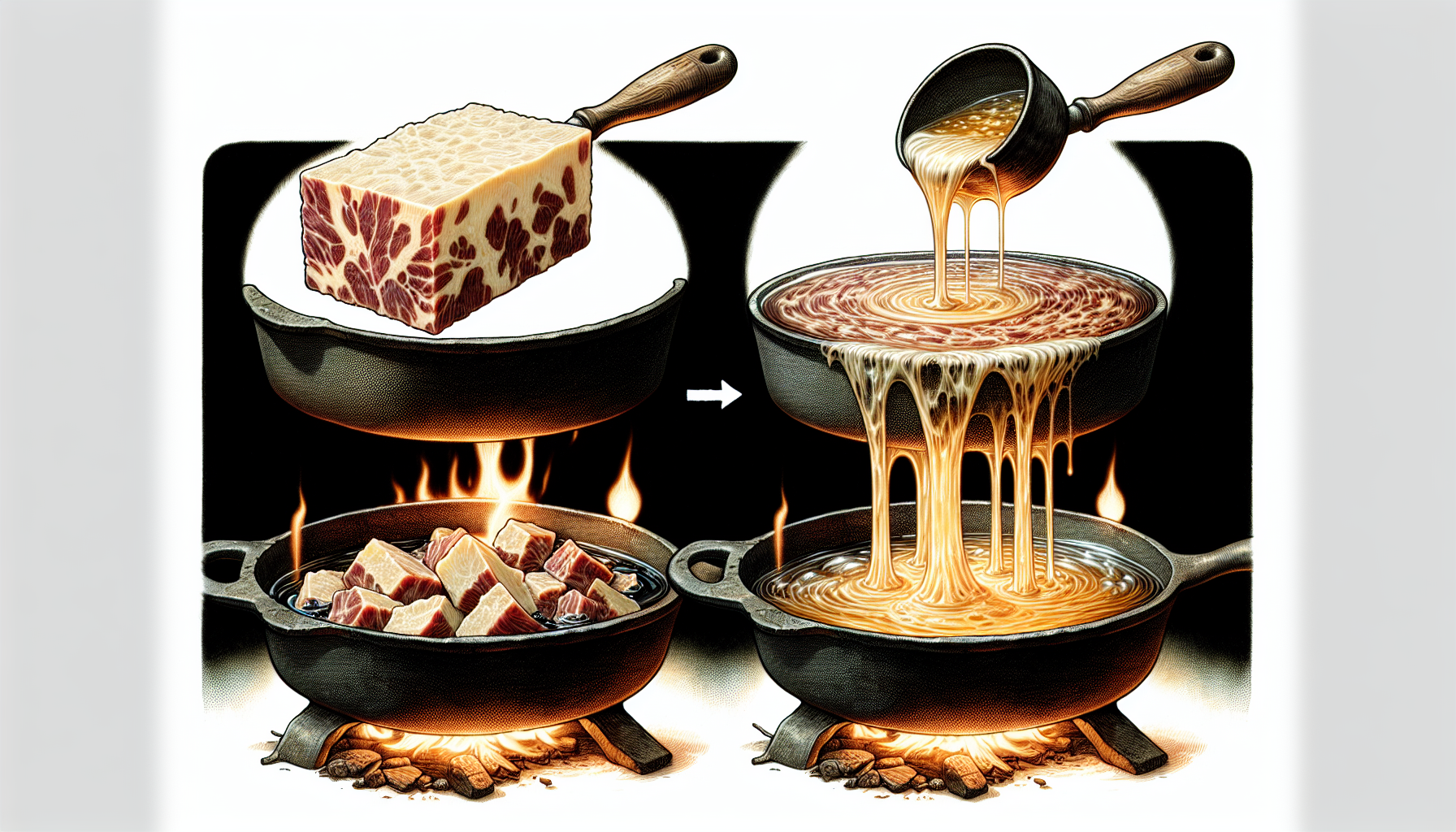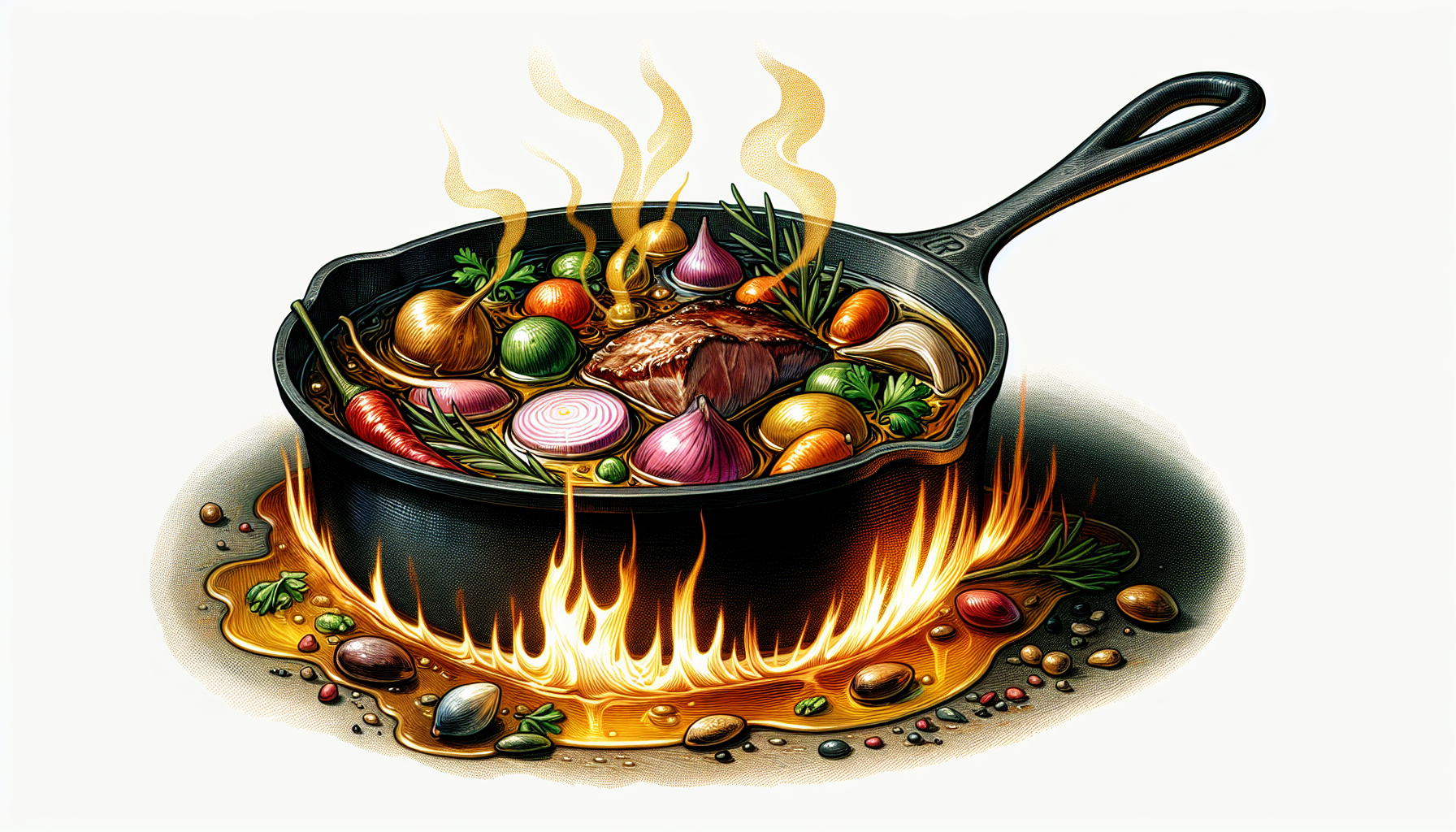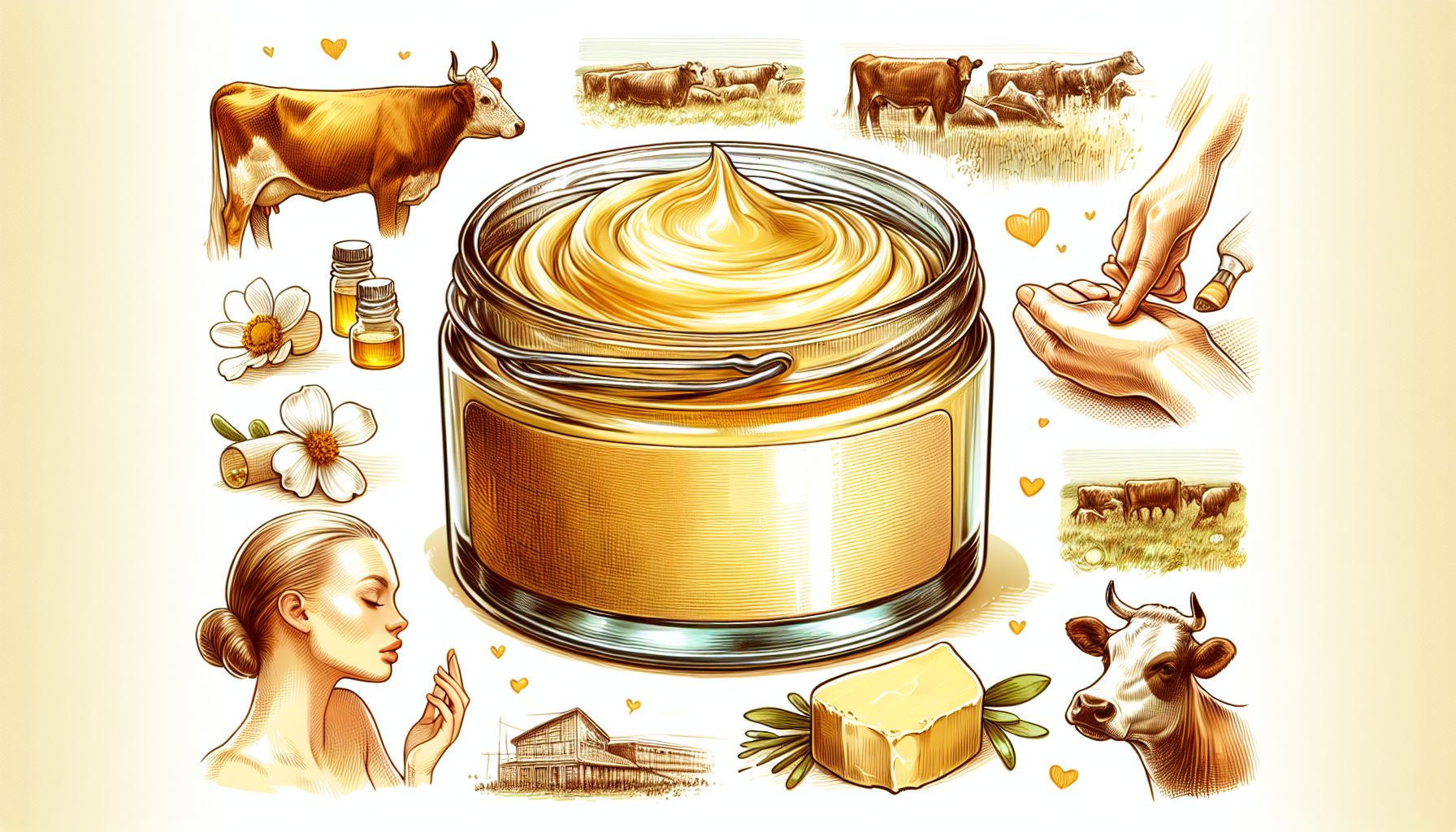Tallow Benefits
Discovering tallow benefits can transform your approach to cooking and personal care. With its abundance of vitamins, superior cooking properties, and skincare compatibility, tallow provides a versatile solution for those seeking natural, effective alternatives. This article uncovers the myriad ways tallow supports skin health and enriches culinary endeavors.
Key Takeaways
- Beef and bison tallow is loaded with healthy fats and fat-soluble vitamins (like A, D, E, K), making it great for heart health and flavorful cooking, while being friendly for those with food allergies.
- With a high smoke point of almost 400°F, tallow is perfect for high-heat cooking, ensuring better-flavored and nutritionally rich foods without the smoke and odor from other oils.
- Tallow isn’t just for cooking; it’s also a skincare hero that mimics our natural skin fats, and it’s part of an eco-friendly, waste-reducing approach to utilizing the whole animal.
Exploring the Nutritional Goldmine of Beef Tallow

Explore the nutritional landscape of beef and bison tallow and discover a gem vastly different from the omnipresent, highly processed and refined vegetable oils that fill our kitchen shelves. Beef tallow is created by rendering the unadulterated suet from cattle, resulting in a rich source of vital vitamins and fatty acids crucial for maintaining heart health and supporting various physiological processes.
Beef and bison tallow is not only free from allergens, catering to individuals with food sensitivities, but also imbues dishes with an intensified taste profile that can transform any meal into an exceptionally tasty experience.
A Treasure Trove of Fatty Acids
Dive into the composition of beef and bison tallow, a rich source of saturated animal fat. This lustrous substance is abundant in healthy fatty acids including monounsaturated, and polyunsaturated fats, and various forms of saturated fats like palmitoleic acid, palmitic acid, and stearic acid. These beneficial fats are celebrated for their cardioprotective properties. Consider the potential benefits where certain fats not only avoid arterial blockage but may also assist in maintaining clean arteries. Notably, stearic acid could enhance cholesterol levels while mitigating inflammation risks that silently compromise health. Monounsaturated fat such as palmitoleic acid has been linked to promoting insulin sensitivity, which is advantageous for regulating blood sugar levels.
To these attributes, beef and bison tallow’s fatty acids profile includes an enhancement provided by conjugated linoleic acid (CLA), acting synergistically against detrimental cellular activities in your body—akin to an internal security team safeguarding your well-being from hidden dangers.
Vitamins for Vitality
Beef and bison tallow, a variety of healthy fats derived from animal fat, is packed with the fat-soluble vitamins A, D, E, and K, which are crucial for numerous bodily functions. These include maintaining vision health, bone strength, immune system robustness and cardiovascular wellness.
These vitamins serve as vital guards against everyday environmental challenges. Among them is Vitamin E, which acts as an antioxidant powerhouse that helps combat oxidative stress known to contribute to chronic conditions. Consuming just 100 grams of beef tallow meets 7% of your recommended daily intake for vitamin D — a nutrient that surprisingly many people lack adequate levels of. Beef tallow assists in maximizing absorption of these critical fat-soluble nutrients, ensuring optimal uptake of beneficial nutrients into the body. Thus, it showcases one facet amongst the myriad health benefits associated with consuming beef tallow.
Indulging in the nutritious properties offered by beef tallow not only protects you from infection but also provides enjoyment through its savory qualities—thus striking a pleasing balance between delectable indulgence and bolstering your well-being with essential nourishment. Uncover all that this resource has to offer and elevate both your meals’ flavor profiles while enriching their nutritional value.
The Superior Smoke Point of Beef and Bison Tallow

Not all cooking fats stand on the same footing. Possessing a significantly high smoke point reaching nearly 400°F, beef and bison tallow outperforms several vegetable oils that are staples in our pantries. What’s the advantage here? It means you can turn up your stove to higher temperatures without the worry of your fat transforming into an unwelcome cloud of smoke, which could impart off-flavors and aromas onto your much-loved recipes. Beef tallow fat is not just resilient for tasks like frying and searing. It also acts as a protector, preserving both taste and nutritional aspects of what you cook.
The stability of tallow owes greatly to its low level of free-fatty acids, granting peace of mind when delving into culinary ventures that demand intense heat. Whether perfecting a steak with an impeccable crust or making a sumptuous roux, beef tallow raises the caliber of home cooking to rival that found in professional kitchens.
The Versatility of Tallow in the Kitchen
Imagine scrumptious, golden-brown potatoes sizzling away, a steak with the perfect char, and a cornbread so rich and tasty that beef tallow must be its secret weapon. This adaptable fat can effortlessly substitute oils and butter in your favorite recipes, delivering an unrivaled richness to every dish it graces. Whether baking sweet treats or sautéing vegetables – or even when deep-frying for that ultimate crispiness – tallow elevates both the flavor profile and nutritional value of your meals.
Beef and bison tallow shines brightly in the art of confit cooking, where its magic renders meat unbelievably succulent at low temperatures over extended periods. Similarly, transforming potatoes into epicurean wonders. Imagine the sheer decadence of enhancing your homemade pastries with just a touch of this luxurious fat—beef tallow turns what’s mundane into pastry perfection sure to tantalize any connoisseur’s palate.
Tallow: A Skin’s Best Friend

Exiting the culinary arena and venturing into skincare, we discover a gentler aspect of beef tallow. Its saturated fats bear a striking resemblance to those in our own skin’s cells, ensuring an unparalleled affinity for seamless integration. When used in skincare products like lotions or balms, tallow imparts essential nourishment that your skin readily recognizes.
In times past, its restorative qualities made beef tallow a trusted remedy for minor injuries such as burns and cuts. Presently, it has found renewed purpose within beauty formulations—balms, ointments and other innovative concoctions—that are gaining popularity among cosmetic aficionados. Whether through hand creams or lip care items to soaps infused with this ingredient. Utilizing tallow infuses daily self-care rituals with both opulence and profound benefits.
We must also acknowledge palmitoleic acid—a distinctive fatty acid celebrated for its protective properties against oxidative stress while stimulating collagen production—the proverbial elixir of youth within the dermal universe. Through topical application or dietary inclusion alike, combinations of beef tallow and virgin coconut oil manifest a comprehensive strategy toward sustaining skin vitality that is simultaneously practical yet lavish.
By choosing soap bars enriched with beef or bison tallow you can experience their sumptuous froth which conscientiously preserves your skin’s inherent moisture defense system resulting in softness imbued hydration post-use.
Conjugated Linoleic Acid: The Fat-Burning Phenomenon in Tallow
Bison tallow’s conjugated linoleic acid (CLA) raises the bar in its benefits, functioning as an influential fatty acid that not only assists with weight control but also serves as a defender against inflammation. Consider it a type of fat that aids in reducing excess weight while simultaneously enhancing your immune system and taking on inflammatory-related conditions such as heart disease and arthritis.
Beef tallow contains stearic acid which acts to promote the metabolism of fats, spurring your body into utilizing stored fat reserves while keeping you feeling full longer. It stands out particularly for those adhering to a ketogenic diet or who aim to manage their weight more efficiently. When it comes to beef tallow, the approach isn’t about eliminating saturated fat alone from your diet. Rather it’s focused on selecting beneficial fats that empower both your physical wellness and health aspirations.
The Sustainable Side of Tallow: Eco-Friendly Practices
Opting for beef tallow transcends mere the health benefits of beef itself. It’s a powerful gesture towards ecological responsibility. Employing tallow reflects our commitment to sustainable, whole-animal utilization—a core tenet of the nose-to-tail philosophy—which respects the entirety of the animal by minimizing waste.
Selecting beef tallow represents more than just a nod to wellness—it’s an active contribution toward an environmentally considerate loop that seeks to limit excess and enhance efficiency. This decision mirrors a profound respect for our culinary ecosystems and embodies dedication to forging a sustainably minded tomorrow.
Creative Uses Beyond Cooking
Tallow’s versatility surpasses its culinary uses, venturing into the sphere of artistic expression. The unassuming grace of tallow candles—made by melting down the fat and shaping it around a wick—not only casts a soft light but also radiates with historic allure, presenting tallow soap an eco-friendly option compared to contemporary wax products.
Taking the spotlight in skincare, tallow is predominantly used as a foundational ingredient for crafting soap. When infused with essential oils, it not only gains additional properties but also exudes enticing aromas. Tallow encourages experimentation beyond gastronomic boundaries, from simple country-style applications to more sophisticated pursuits.
Choosing the Right Tallow for Your Needs
Delving into the realm of tallow requires thoughtful choices. When you choose beef and bison tallow derived from grass-fed stock, you not only contribute to more sustainable ecosystems but also procure a superior-quality beef and bison fat. For those inclined towards culinary adventures, consider making your own tallow. Doing so ensures that you have access to a clean and non-hydrogenated fat source, which is often healthier compared to many options found in stores.
The process of rendering your own tallow at home may seem daunting initially. It’s quite straightforward with some basic kitchen tools and patience. This method allows you to convert raw fat from grass fed bison into lustrous and beneficial beef tallow for various applications—a fulfilling endeavor that enhances your connection with the food on your table while giving you greater control over the ingredients in your healthy diet too.
Summary
As we wrap up our exploration of beef and bison tallow, it’s clear that this traditional fat is more than just a relic of the past. It’s a multifaceted gem that offers a wealth of health benefits, culinary versatility, and sustainable practices. Whether you’re frying up a storm in the kitchen, nurturing your skin to a radiant glow, or crafting homemade candles, beef tallow stands out as a testament to the power of simplicity and tradition in our modern lives.
So why not embrace the richness of tallow? Let it transform your cooking, enhance your cooking oil, your skincare routine, and align your lifestyle with eco-friendly values. With tallow, you’re not just making a choice for today; you’re investing in a healthier, more sustainable tomorrow. Let this guide be your starting point, and may your tallow journey be as enriching as it is delicious.
Frequently Asked Questions
Is tallow healthier than olive oil?
No, compared to olive oil, tallow is not regarded as more beneficial for health because it has saturated fatty acids, a reduced antioxidant capacity, and does not contain linoleic acid. When selecting oils for cooking, it’s crucial to balance fatty acid content with antioxidant capabilities.
Can beef and bison tallow be used for high-heat cooking?
Certainly, owing to its high smoke point reaching nearly 400°F, beef tallow is suitable for cooking at high temperatures. This property makes it perfect for frying and searing as it doesn’t produce undesirable smells or tastes.
What are some skincare benefits of using beef or bison tallow?
Beef tallow is excellent for skin care due to its similar fatty acid profile to human skin, which encourages hydration, elasticity, and general well-being. It’s incorporated into skincare items because of its therapeutic benefits.
Consider using beef or bison tallow if you’re aiming for skin that is both nourished and hydrated!
Is choosing beef and bison tallow a sustainable option?
Certainly! Opting for beef or bison tallow promotes sustainability by minimizing food waste and optimizing the utilization of animal byproducts. This environmentally conscious choice is in harmony with the principles of nose-to-tail consumption practices.
